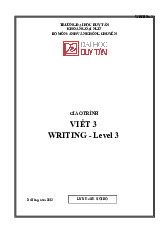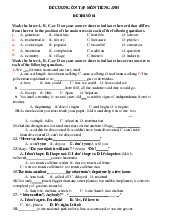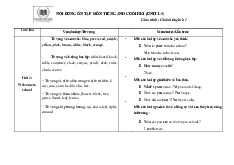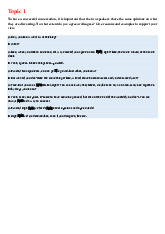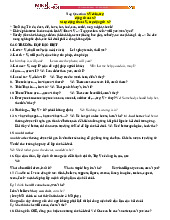














Preview text:
lOMoAR cPSD| 46836766
A STUDY ON HYPONYMY AND MERONYMY IN LEXICAL SEMANTICS
AND IT USES IN “THE DEVOTED FRIEND”-OSCAR WILDE PART I: INTRODUCTION I. Rationale
Semantics along with other subjects like Grammar. Phonology and Phonetics,
Lexical, so on stands in the system of academic language. It is researched
systematically with a lot of different points of view and approaches which are
argued by many famous linguisticians like J. Lyons (Cambridge University);
Curse, D.A (Cambridge University); Chaffin, R & Winston, M.E (Trenton State
College); Herman D (Hamilton College); and so on.
Semantics is not only researched but also learned in universities. To major students
at VNUA like me, semantics is a new subject in the curriculum, which brings us
both excite and challenge. Furthermore, for myself, it really attracts me in the
studying at class for its strangeness, especially Hyponymy and Meronymy. These
two types of the sense relations are popular in life particularly in scientific field.
They are used to express hierarchical relations. Besides, they also show the
certainly mutual correspondence and distinction as well, which urges me to study this issue more profoundly.
That is the reason why Hyponymy and Meronymy are chosen to be my study. II. Aims of the study
With the study, I hope to satisfy readers with knowledge gap in Semantics
and open new direction for further study. Specially, I would like to achieve the following aims:
- State certain aspects in Hyponymy and Meronymy.
- Point out the use of Hyponymy and Meronymy in “The Devoted Friend”Oscar Wilde III. Scope of the study
Hyponymy, Meronymy and the distinction between them are complicated
and profound issues in Lexical semantics, which relate to a lot of lexical
relations like Taxonymy, Meronomy, and Hierarchical relation. Therefore it
is difficult for me to analyze clearly their relationship between them and the two sense relations.
Due to the limited time and knowledge, my study just emphasizes on
outstanding aspects of the two sense relations as mentioned in the design. I lOMoAR cPSD| 46836766
always percept my restricted understanding in Semantics, generally
speaking and Sense relations individually speaking, therefore it will be not
wise if further issues of Hyponymy and Meronymy like their relationship
with other semantic relations, their application in detail, etc. are mentioned
with the carelessness in the study. Conversely, the aspects such as
Definition, Types, Features, Contrastive analysis of Hyponymy and
Meronymy will be stated in detail in the study.
In my hope, the study will not be too restricted and can give the reader a little referential knowledge. PART II: DEVELOPMENT
CHAPTER I: The theoretical background I. Hypnonymy 1. Definition
The relation between two classes in lexicon often present in four basic relations. They
are identity (two classes have the same members), inclusion (one class is entirely in
another class), overlap (two classes have the same members but each one has its own
members), and disjunction (two classes have no members in common). The lexical
relation corresponding to the inclusion one class in another is Hyponymy (Cruse,
1986). For instance, class ‚chair‛ is included in class ‚furniture‛ because the former belong to the latter.
In sense relations, Hyponymy is regarded as the relation of generality/specificity. If we
want to refer to something, e.g. a dog, we have several possibilities to express this: We
could say ‘spaniel’ (only, of course, if we talk about a spaniel), ‘dog’ or ‘animal’. It
becomes clear that these lexical items are of ‚different levels of specificity‛ (Cruse,
1975) , and what we finally say depends on our point of view, whereas no one will
disagree that ‘spaniel’ is more specific than ‘dog’, which itself is more specific than ‘animal’.
From two above opinions of the term of Hyponymy, it is possible to define that
Hyponymy is a relation of inclusion between two classes or two words in which one
class or word more general in term of meaning involves another class or word whose meaning is more specific. 2. Ingredients lOMoAR cPSD| 46836766
Hyponymy expresses the relationship between two words, in which the word
belonging to the genus and more general is called Superordinate or Hypernym, the
other carrying the characteristics of the species and more specific is called Hyponym.
Hypernym refers to words carrying extensional meaning. It is broad enough to cover
the Hyponym. For example, the word ‚animal‛ is Hypernym of the words ‚dog‛, cat,
mouse, etc.‛ because it holds notion of all the words ‚ dog, cat, mouse‛; whereas,
Hyponym refers to words presenting inclusion meaning. It covers both the general
meaning of its Superordinate and the specific one of itself. For instance, the word
‚rose‛ carrying characteristics of a flower, in general, it also includes its individual features.
Sometimes a Superordinate may be a Superordinate to itself. For instance, the word
animal may only include beasts like tiger, lion, elephant, cow, horse and is a
cohyponym of human. But it is also the Superordinate to both human and animal in
contrast to bird, fish, and insect, when it is used in the sense of mammal. Furthermore,
animal is also the Superordinate to bird, fish, insect and mammal in contrast to plant.
From the other point of view, the hyponym's point of view, animal is a Hyponym of
itself, and may be called Auto-hyponym in that the same lexical item can operate at
both Superordinate and Subordinate levels; for example, ‚man‛ contrasts with ‚animal‛
at one level, but at a lower level it contrasts with ‚woman‛ (in effect, ‚a man is a kind of man‛). lOMoAR cPSD| 46836766
The relation between Hypernym and Hyponym is asymmetrical relation, in which a
Hypernym can have many Hyponyms that are types of their Hypernym. The following
example will illustrate the statement:
In the tree-gram, the sense relation of Hyponymy is express in levels. The former the
level is, the more general it is. The relation between levels is called hierarchical
relation. Level 1 called mother-nodes is Hypernym of level 2 (daughter-nodes) and
level 3. Similarly, level 2 is Hypernym of level 3. The relation between words in the
same level is named as sister-nodes (creature, plant) and in the sense relation of
Hyponymy; they are called Co-hyponym. Co-hyponyms in Hyponymy are strict imcompatibles (Cruse, 1986). 3. Types
Murphy (2003) & Chaffin (1984) argue there are different kinds of Hyonymy
according to the property of concept, and define six types of Hyponymy: perception
(horse-animal), function (car-vehicle), geography (Russia-country), activity
(chessgame), state (fear-emotion and action (frycook).
Moreover, Miller (1998) defines two main types of the kind-of relation: Taxonymic
and functional Hyponymy, in which Taxonymy plays the central role in the lexical
hierarchy. While Taxonymy is the ‚is-a-kind-of‛ relation, Functional Hyponymy is
known as the ‚is-used-as-a-kind-of‛ relation. For example, cow is in a taxonomic
relation to animal (a cow is an animal), but in a functional relation to livestock (a cow
functions as livestock). The functional relation is more tenuous because it is not a
logically necessary relation: not every cow is livestock; not every dog is pet.
Taxonymy, one the other hand, is more analytic. 4. Some features 4.1. The entailment lOMoAR cPSD| 46836766
Entailment is relationship that applies between two propositions, where the truth of one
implies the truth of the other (Nguyen Hoa 2004). Because the meaning of words in
Hyponymy include, Hyponymy involves the entailment.
The entailment often occurs in the formulation ‚A is X entails A is Y, if Y is Superordinate of X‛. e.g.
This is a dog. entails This is an animal.
He is my father. entails He is my parent.
The entailment is also true to words being Adjectives and Verbs:
Bill murdered someone. Entails Bill killed someone.
She wore scarlet hat. entails She wore red hat.
It is possible to formulate rules for predicting the direction of entailment if the
Hypernym and Hyponym fall within the scope of a negative, or a universal quantifier
(e.g. all, every, each), or if they form part of conditional clause or other expression of
contingency, then the direction of entailment will be reversed (Cruse, 1986). E.g.
It’s not red. entails It’s not a scarlet.
All animals are forbidden. Entails All dogs are forbidden.
If it is red, it will be rejected. entails If it is scarlet, it will be rejected. Cruse (1986:89) 4.2. Substitutive possibility
The relation of Hyponymy reflects the point of view of intention and extension. It
means the term of Hyponym already involves both a wider meaning of the term of
Hypernym and the specific meaning of itself (e.g. ‚rose‛ is a member of ‚flower; thus it
has both general characteristics of a flower and individual one of a rose); therefore it is
possible for them to exchangeable. For example we can say:
I bought a Honda yesterday. The car is not expensive.
The substitutive possibility not only involves nouns but also verbs and adjectives as well: - Did she kill him? - Yes, she murdered him. Hoa (2000:122-123)
Even though Hyponymic relation makes substitution possible, there is no Hypernym
which is replaced by a Hyponym but there is a Hyponym replaced by a Hypernym.
This has been already proved as in the above example. Then there will be an example
to demonstrate the contrast opinion: lOMoAR cPSD| 46836766
I have a motorbike. My brother does not like the Yamaha. (?)
The given sentence seems logical; however, it is not possible to imply a motorbike is a
Yamaha which is also a kind of motorbike. Motorbike can be Honda, SYM, Suzuki or
any brand of car; it is not necessary a Yamaha. Thus the substitutive possibility only
happens in one-sided direction (it is true to the case of Hypernym substitutive for Hyponym). 4.3.
Taxonymy as a sub-type of Hyponymy
As other relations, Hyponymic relation can be divided subtypes. However, it is not
identical in the linguisticians’ classification ideas. In other word, Hyponymy has many competing subtypes.
Moreover, Miller (1998) argues the Taxonomic and Functional properties of concepts
should be concerned in the Hyponymic relation. In addition, Cruse (1986) defines
Taxonimic relation as the subtype of Hyponymy, which is the central role in this relation.
Taxonomic lexical hierarchies are based on the sense relation referred to as taxonymy.
Taxonymy is in fact a subtype of hyponymy since the taxonyms of a lexical item form
a sub-set of its hyponyms. Taxonymy is defined as the relation of dominance in a Taxonomy.
The relation of Taxonymy is often seen in a useful diagnostic frame: An X is a kind/ type of Y
E.g. A spaniel is a kind of dog. A rose is a kind of flower. A lemon is a kind of fruit.
It is also right to say: A spaniel is dog. A rose is flower. A lemon is fruit.
If X is Taxonym of Y, it is possible to state as the above example. However, if an X is
a Hyponym of Y, whether it is possible to say that:
A small spoon is a kind of spoon. (?)
A white shirt is a kind of shirt. (?)
The answer is it is not because the terms ‚small spoon‛ and ‚white shirt‛ are
respectively not exactly a kind of spoon and shirt. It is only possible to say ‚a small
spoon is spoon or a white shirt is shirt, although it is rather forced. lOMoAR cPSD| 46836766
Therefore, not all Taxonyms are good Hyponyms. The Taxonymic relation and
Hyponimic relation thus are different. 4.4.
Synonymy as the special case of Hyponymy
Hyponymy is related to Synonymy(Nguyen Hoa 2004). If a lexical item has the same
meaning as another’s, they are considered Synonyms. However, in terms of
Hyponymic relation, they are Hyponyms of each other. For instance, both ‚mercury‛
and ‚quicksilver‛ reflects the same reference, they are synonyms but they are
Hyponyms of each other as well.
There would be a formulation of such case that if X is a Hyponym of Y and Y is a
Hyponym of X, then X and Y are synonyms of each other. This can be implied
bidirectionally. For example, if ‚mercury ‚ and ‚quicksilver‛ are synonyms, then they are Hyponyms of each other.
Therefore, Synonymy can be considered as a special case of Hyponymy and may called Symmertrical hyponymy. II. Meronymy 1. Definition
The semantic relation of Meronymy or called Part-Whole relation. is another kind of
sense relation. Meronymy is the semantic relation existing between a lexical item
denoting a part and an item denoting the corresponding whole (Radek Vogel, Masaryk
University).The notion of Meronymy is popularly in natural environment (finger-hand,
pupil - eye) or in technical disciplines (bicycle - pedal, computer - screen). Meronymy
reflects the result of division of analysis of an entry into parts or components in that
the relation between the whole and its component is called Meronomic relation. For
example, “a body” is divided into “hand, head, leg, ect.” ; the semantic relation
between “a body” and one of lexical item “hand, head, leg” is Meronymy. Metonymy
applies not only to the entries that have concrete reference but also to abstract ones, e.g. lOMoAR cPSD| 46836766
The term “day” occurs twice in this example; however, this term expresses two lexical
meanings: the first time it refers to the period of twenty-four hours and the second it
reflects the part of that period which enjoys daylight. Therefore, the lexical relation in
this case is Meronymy. It also reflects the same as in the relation between “night” which
is in contrast with the second meaning of “day” and “day” referring to the darkest part of it. 2. Ingredients
In the Meronomic relation, there are two members. The entry divided into parts is called
Holonym or Superordinate, and the other - Meronymy. The term of Holonym presents
the wholeness as an upper class, Meronym - the lower class is the lexical item expressing
the parts. Therefore, the relation between two lexical items “knife – blade” in the concept
“blade is a part of knife” is the semantic relation of Meronymy, in which “knife” is
Holonymy and “blade” is Meronym. The relation between Holonym and Meronym
sometimes fluid; it is exchangeable, e.g.
In this example, the term Holonym is homonym of its Meronym. This show that a
Holonym is able to have Meronymy being itself ver vice a Meronym likely has Holonym
being itself; in Meronomic relation this may be called GGG. While the mother-node
“body” must be Holonym of “head, body, limb”, the terms “head”, “body”, “limb” in
the sisterhood relation, as the sense relation of Hyponymy, are called Co-meronym. 3. Types
Like the Hyponymy relation, Meronymy also divided into different kinds. Cruse (1986)
distinguished two subtypes of Meronymy: necessary Meronyms (ear-body) and optional lOMoAR cPSD| 46836766
Meronyms (beard-face) to show some object were the direct parts of the whole, while
some were attached parts. Additionally, Chaffin & Herrmann (1987) explored the
relation elements and suggested six types of Meronymy. Winston et al. (1987)
considered the function, homeomeria and separability to interpret the types of
Meronymy relation which is shown in the following table: 3.1. Component – integral object
This is the relation between the components and the objects to with they belong. For example: A handle is a part of a cup. Wheels are parts of cars.
The refrigerator is a part of the kitchen.
(http://www.citeulike.org/user/cwmaier/article/995833)
Integral objects have the structure; their components are separable and have a functional
relation with their whole. Some components may be optional; while the integral object
may not be extensive (i.e. they may not occupy same physical space as in phonology part of linguistics) 3.2. Member – collection
Member - collection relation represents membership in a collection. Members are parts,
but they cannot separated from collections and do not play any functional part with respect to their whole. A tree is part of forest. A juror is part of a jury.
This ship is part of a fleet.
(http://www.citeulike.org/user/cwmaier/article/995833)
Membership in a collection differs from componenthood in not requiring that member
perform a particular function or possess a particular structural arrangement in relation
to each other and to their whole.
Collection whose members are determined by social connection are generally referred
as “group”. This relationship is often expressed by the phrase ‚a/the member of‛. For example:
Vietnam is the member of Asian. Chine is a member of WTO.
(http://www.citeulike.org/user/cwmaier/article/995833) 3.3. Portion-Mass lOMoAR cPSD| 46836766
Portions of masses, extensive objects, and physical dimensions are different from
components of objects and members of collections in being “homeomerous” that is,
having parts which are similar to each other and to the wholes which they comprise, as in, This slice is part of a pie. A yard is a part of mile.
This hunk is part of my clay.
(http://www.citeulike.org/user/cwmaier/article/995833)
The portion - mass sense has been distinguished from other senses of “part of” by Sharvy
(1980, 1983). He suggests that mass and count senses of can be distinguished by
replacing “part of” with “some of”. When “part of” is being used in the mass portion sense, as in,
She asked me for a part of my orange.
We can readily substitute “some of” while preserving meaning:
She asked me for some of my orange.
(http://www.citeulike.org/user/cwmaier/article/995833) 3.4. Stuff-object
The stuff - object category encodes the relation between an object and the stuff of which
it is partly or entirely made. The parts are not similar to the whole thay comprise, cannot
be separated from the whole, and have no functional role.
The stuff-object relation is often expressed by phrase “is partly”. For example: The bicycle is partly steel. Wine is partly alcohol. Teeth are partly calcium.
(http://www.citeulike.org/user/cwmaier/article/995833) 3.5. Feature-activity
The existence of a fifth type of Meronymic relation is indicated by the use of “part” to
designate the features or phrases of activities and processes, e.g. Paying is part of shopping.
Bidding is part of playing bridge.
Ovulation is part of the menstrual cycle.
Dating is part of adolescence.
(http://www.citeulike.org/user/cwmaier/article/995833) lOMoAR cPSD| 46836766
Unlike the type of Meronymy discussed thus far, the feature - activity relation cannot be
expressed in sentences of the type “X has Y”, and similar locutions (Cruse, 1986), such as, Sororities have members. Bicycle has pedals. Play has acts. ? Shopping has paying.
(http://www.citeulike.org/user/cwmaier/article/995833)
Apart from this difference, the feature - activity relation is like the component integral
object relation in that complex activities are structured by means of “scripts” which
assign locations to particular sub-activities or features (Shank & Abelson, 1976), just as
integral objects are made up of components. When used in relation to complex or
“scripted” activities or events, the term “part” can be used to refer to stages, phrases,
discrete periods, or sub-activities which are included in the “script”. When we move
from speaking of generic king of activities to describe events, e.g. “war” to ‚World War
II‛, we use this same meronymic relation. 3.6. Place-area
A sixth type of Meronymy is the relation between areas and special places and
locations within them, as in the following:
The Everglades are part of Florida.
An oasis is a part of desert.
The baseline is a part of tennis court.
(http://www.citeulike.org/user/cwmaier/article/995833)
Like the member of collection, places are not part by virtue of any functional
contribution to the whole. Like the portion - mass relation, the area - place relation is
homeomerous; every place within an area is similar to every other and to the whole area
in that all are areas. Unlike portions of masses, however, places cannot be separated
from the areas of which they are a part. Once again, this relationship differs from the
other basic types of Meronymy, though it does give on kind of answer to question “What are its parts”
III. Lexical relation of Hyponymy and Meronymy
The branch of semantics that deals with the word meaning is called lexical semantics. It
is the study of systematic, meaning related structures of words. Lexical field or semantic
field is the organization of related words and expressions in to a system, which shows lOMoAR cPSD| 46836766
their relationship with one other. E.g. set of ―angry, sad, happy, and afraid‖. This set
of words is a lexical field; all its words refer to emotion states.
Lexical semantics examines relationships among word meanings. It is the study of how
the lexicon organized and how the lexical meanings of lexical items are interrelated, and
it is principle goal is to build a model for structure of the lexicon by categorizing the
types of relationship between words, which is called lexical relation.
Definition: A lexical relation is a culturally recognized pattern of association that
exists between lexical units in a language.
There are different types of lexical relations: Synonymy, Homonymy, Metonymy,
Polysemy, Hyponymy, Meronymy, in which each relation reflects the different
association of lexical units in a language.
In lexical relations, Hyponymy is considered as the relation of inclusion. The members
in Hyponymy relation – Hypernym and Hyponym denoting the terms referring the same
object, but the former is boarder than the latter.
There is always an expression to recognize which term is Hypernym and which term is
the other. Hyponym is considered as the ―is-a‖ relation (Cruse, 2002) that is possible
to be expressed by the verb to be. For example: A stallion is the horse. A dog is an animal. Cruse (2002)
The terms “stallion” and “dog” are identified the Hyponyms, while “horse” and
“animal” is called the Hypernyms. Moreover, the relation of Hyponymy is formulated
in the following phrase: X is a kind/type/sort of Y (Radek Vogel, 2006) as the concern
of Taxonymy relation – subtype of Hyponymy. For instance, Rose is a kind of flower.
Therefore this relation, in other word, is called the “kind of relation”.
While Hyponymy reflects to “is-a” relation, the other hierarchical relation is regarded
the “part-of” relation (Winston, Chaffin & Herrmann, 1987; Artale, Franconi, Guarino
& Pazzi, 1996). It is thus expressed by phrase: “X is a part of Y”. e.g. “Finger is a part
of hand” or “head is a part of body” The difference between Hyponymy and Meronymy
in terms of Lexical relation, therefore, is that the lexical relation between the terms
“arm”, “eye”, “hand”, “head”, for example, an arm is not a kind of “body” like a rose is
a kind of flower, but a part of body. It is possible to state that the relation of Hyponymy
structures hierarchically concepts according to logical aspects, thus “rose” is classified
basing on general and individual characteristics of its that make it put into kinds of
“flower” ( because of general characteristics) and identified to be “rose” (because of lOMoAR cPSD| 46836766
individual characteristics). On another hand, the relation of Meronymy reflects a
physical point of view (Khoo & Na, 2006), which is easy to be seen in the given
example: “head”, “arm”, “eye” or “hand” relate to “body” according to the nature or
material things. The relation of members in Meronymy, therefore, is closer than ones in
Hyponymy. In short Hyponymy and Meronymy have a lot of expressions. They are,
however, distinguished by the lexical relation of “kind-of relation” for the former and
“part-of relation” for the latter.
IV. Hyponymny and Meronymy in “The devoted Friend”-Oscar Wilde 1. Methodology
As I mentioned in the first part, the aim of this paper is to understand about how
to use Hyponymy and Meronymy in English, but so far, how the English author
use it type of grammar. But due to the limited length, limited time, I have to devied
all the words metioned before to 2 board so that I can analyze as clearly as I can.
Here is Hyponymy and Meronymy in “Devoted Friend” 2. Result a. Hyponymy No Hyponymy No of occurences % 1 The entailment 65 51.5 2 Substitutive possibility 23 18.2 3
Taxonymy as a sub-type of Hyponymy 31 24.6 4
Synonymy as the special case of Hyponymy 7 5.7 Total 126 100 b. Meronymy No Type of Meronymy No of occurences % 1 Component/ Integral 31 24.2 lOMoAR cPSD| 46836766 2 Member/ Collection 3 2.3 3 Portion/ Mass 20 15.6 4 Stuff/ object 1 0.7 5 Feature/ Activity 56 43.75 6 Place/ Area 17 13.2 Total 128 100 3. Finale result
- Hyponymy: From the above table, we can analyze that Oscar Wilde uses the
entailment for 65 times, followed by Taxonymy as a sub-type of Hyponymy with
31 times, substitutive possibility for 23 times, and the last is synonymy as the special case of Hyponymy
- Meronymy: From the above table, we can see the most uses of Meronymy is
feature/activity, next is component/integral, followed by portion/mass and
place/area, member/collection, and last is stuff/object PART 3: CONCLUSION
Hyponymy and Meronymy are the popular relation seen in lexical semantics. They are
discussed in the correlativeness with the other relation, such as sense relations,
paradigmatic relations, lexical relations, hierarchical relations which base on the
fundamental relationship of generality and specificity relation. In the study, the relations
of Hyponymy and Meronymy are interpreted by a mention of definition, expression,
common types, and some typical feature. lOMoAR cPSD| 46836766 REFERENCES
1. Allan, K. (2001). Natural Language Semantics. Oxford: Blackwell.
2. Chaffin, R, & Herrmann, D. J. (1984). The similarity and diversity of semantic
relations. Memory and Cognition, 12, 134-141.
3. Cruse, D. A. (1986). Lexical semantics. Cambridge: Cambridge University Press.
4. Cruse, D. A. (2002). Hyponymy and its varieties. In R. Green, C. A. Been, and S. H.
Myeang(eds.), The semantics of relationships. Dordrecht: Kluwer, 3-22.
5. Jackson, H, & Amvela, E. Z. (2000). Words, meaning and vocabulary: an
introduction to modern English lexicology. Language Arts & Disciplines.
6. Lyons, J. (1977). Semantics. Volume 1. Cambridge University Press
7. . http://bbs.dage.name/viewthread.php?tid=1425
